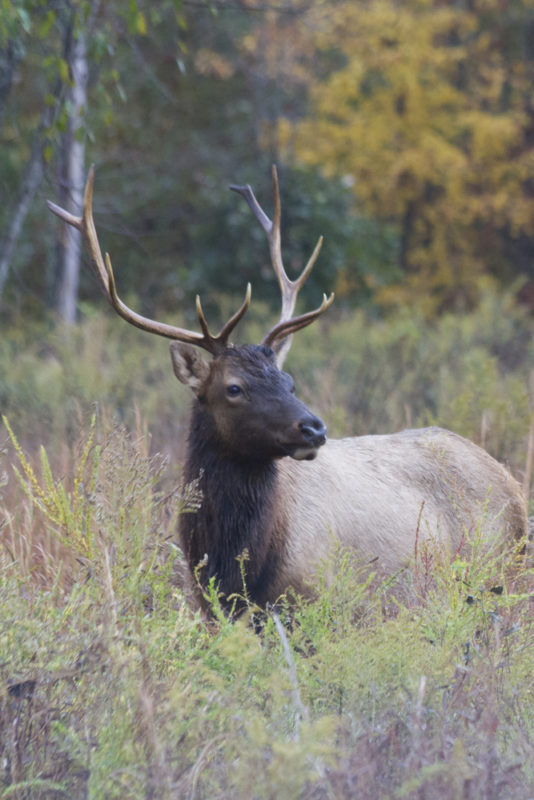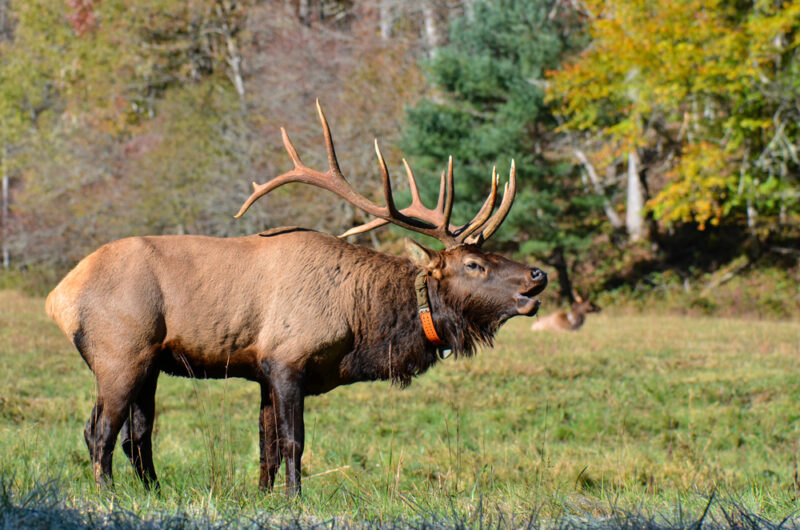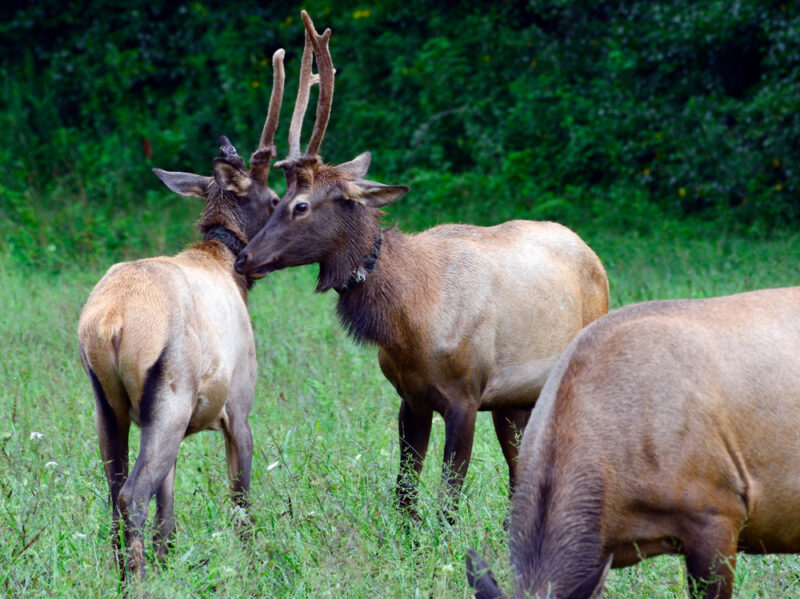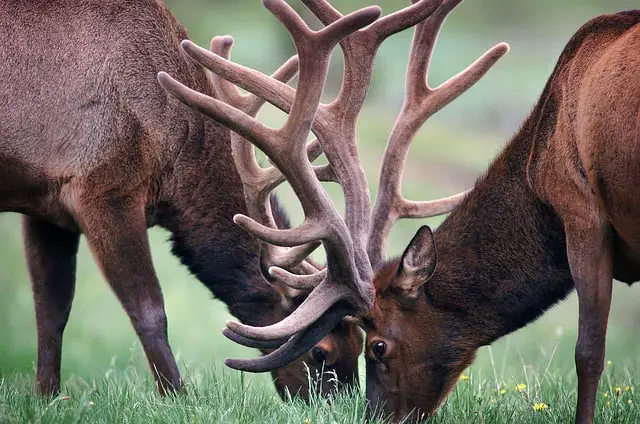According to the latest estimate from the Tennessee Wildlife Resources Agency, the population of elk living within the state numbers over 400 animals. This hasn’t always been the case, though. Although elk are part of Tennessee’s native wildlife, for a time, they were completely extirpated from the state.
Both Elk and bison were a common sight in Tennessee in the time before it was colonized by European settlers. Just as they were over much of North America. Early explorers of the area documented vast grasslands and abundant big game animals, including bison, elk, deer, and black bears.
The history of elk in Tennessee mirrors the history of elk in the entire Eastern United States. Habitat loss due to the land being claimed for homesteads and unregulated hunting are factors that led to the demise of elk within the state. In the late 1800s, the state of Tennessee had a total extinction of elk from its borders. The last historical record of an elk in the Tennessee wilds was in 1865. At that time, a hunter killed an elk in Obion County. Since then, there are no more historical records of native Tennessee elk. In fact, Eastern elk (Cervus canadensis canadensis), which is the species of elk that once lived in Tennessee as well as most of the eastern states in the US and the provinces of southeastern Canada, are extinct.
Tennessee Elk Restoration Project
Part of the mission of the Tennessee Wildlife Resources Agency is to restore extirpated wildlife species when it is biologically and physiologically viable. Consequently, in the late 1990s, the TWRA decided to bring elk back to Tennessee.
When the TWRA reintroduced elk to the state of Tennessee, they worked in partnership with the Rocky Mountain Elk Foundation, the Tennessee Wildlife Federation, the Campbell Outdoor Recreation Association, and the Tennessee Wildlife Resources Foundation.
The reintroduction of elk in Tennessee began on December 19, 2000. On that day, Tennessee Wildlife Resources Agency officials released 50 elk on Horsebone Ridge, which is in the Cumberland Mountains, in the Royal Blue Wildlife Management unit of the North Cumberland Wildlife Management area. These were the first wild elk to inhabit the state in over 135 years.
Subsequently, the Tennessee Wildlife Resources Agency released more elk into the state in 2001, 2002, 2003, and 2008. Resultantly, by March of 2008, the Tennessee Wildlife Resources Agency had released a total of 201 elk back into the volunteer state.

Where did Tennessee’s elk come from?
The initial elk that the TWRA released on Horsebone Ridge came from Elk Island National Park in Alberta, Canada. State wildlife agencies consider Elk Island to be one of the best places in the world to source wild disease free elk. This is due to the fact the Canadian Government closely monitors the EINP elk herd for potential health problems.
Subsequent releases came also came from Elk Island National Park. However, the state of Tennessee also procured elk from the state of Kentucky’s Land Between the Lakes National Recreation area. Incidentally, the elk at Land Between the Lakes also originated from Elk Island National Park.
The subspecies of elk from Elk Island National Park are Manitoban elk (Cervus elaphus manitobensis). Biologists believe that the extant elk sub-species that is most closely related to the extinct eastern elk that once inhabited Tennessee, as well as most of the eastern U.S., is the Manitoban elk. Compared to Rocky Mountain elk (Cervus canadensis nelsoni), which inhabit a great portion of the western United States and Canada, Manitoban elk are larger-bodied, and the male elk (bull elk) have slightly smaller antlers. See

Where is the Tennessee Elk Restoration Zone?
The Tennessee elk restoration zone consists of 670,000 acres which are located in Scott, Morgan, Campbell, Anderson, and Claiborne Counties. The center of the zone is the North Cumberland Wildlife Management Area. This part of the state was selected for elk reintroduction because it has a large percentage of public lands and also because of the relative scarcity of private lands. Even a small herd of elk can potentially do great damage to agricultural crops. This is why, for example, West Tennessee, which is one of the most productive cotton-producing regions in the nation, is not a good candidate for elk reintroduction.
If it’s possible, any elk that wander outside of the restoration zone is captured and moved back within the restoration zones boundaries. Any elk that wander outside of the restoration zone that is not capturable is destroyed.
Hatfield Knob Elk Viewing Tower
The Hatfield Knob Viewing Tower, which is a public viewing area for elk, has drawn thousands of wildlife enthusiasts from around the country since the first year it opened in 2005. People travel there to get a look at the first wild elk population to inhabit the area since the 1860s. The elk viewing tower is within the Sundquist Wildlife Management Area, which is, in turn, part of the North Cumberland Wildlife Management Area in Campbell County, Tennessee. A study which was conducted by the University of Tennessee determined that around 16,000 people visit the tower annually. What’s more, thousands more individuals view elk live through a TN elk cam that was installed on the tower by the TWRA.
The best times to view elk at the Hatfield Knob Elk Viewing Tower are in the early morning, just after sunrise, and in the evening, just before sunset. Elk are more likely to be bedded down in the timber during the warmest portion of the day. What’s more, they are naturally skittish animals and are less likely to be out in the open during peak times of human activity.
The very best time to view elk is during the rut or, in other words, during their mating season. Elk generally rut from about mid-September through the end of October. During this time, the dominant herd bulls gather up harems of cows or, in other words, female elk to mate with. What’s more, bulls battle for dominance and the right to be a harem bull. During this time, the air is filled with the grunts, bugles, and squeals that bull elk make as they call out challenges to their competitors and amorous calls to any cow elk in the area.
Elk Hunting in Tennessee
According to Greg Wathan, who is the TWRA wildlife division chief, “When the elk program began, they had two objectives. One was to have an elk herd to provide wildlife viewing. The second objective was to have a huntable elk population.“
By the year 2009, the state of Tennessee’s wild elk herd had grown to around 300 animals. At this level, TWRA officials felt that a limited elk hunt could be conducted. After a couple of years of delays, state wildlife officials conducted the first elk hunting season in Tennessee since the time of the Civil War in October of 2009.
Tennesee’s first elk hunt fielded 5 hunters. Of these, 4 were selected from almost 13,000 applicants in a random computer drawing. The fifth permit was awarded to the high bidder in an auction where the proceeds were used to benefit Tennessee’s elk restoration. Each successful applicant was allowed to choose which elk hunt zone they wanted to hunt in, in the order of when their permit was drawn.
On October 19th of, 2009, Charles Flynn from Rockford, Tennessee, went down in history as the first individual to legally harvest an elk in the state since 1865. Mr. Flynn was joined on his historic hunt by friends Kasay Thomas and Calvin Hinse. Additionally, Harold Knight and David Hale from Knight and Hale Wildlife Calls filmed video of the hunt for their TV program. Craig Gardner of Parrottsville, Tennessee, and Ronald Woodard of Oak Ridge, Tennessee, also harvested elk on October 19th, but these were slightly later in the day. See
Through the years, the number of elk in Tennesse has increased. Consequently, the Tennesee wildlife resources agency has increased the number of elk permits available. For instance, in 2023, there are a total of 14 available elk permits in Tennessee. Seven of these are for archery only, while 6 of them are for choose your weapon between archery, riffle, or muzzleloader. The remaining permit is a youth permit. The age requirement for the youth permit is a resident youth 13 to 16 years of age. Young sportsmen must be accompanied by a non-hunting adult 21 years of age or older. The accompanying adult must remain with the youth hunter in a position to be able to take immediate control of the weapon.
With the exception of the North Cumberland WMA, all public land in Tennessee is closed to elk hunting. In regards to private property hunting, it is the responsibility of the elk permit holder to secure verbal or written permission from the land owner to hunt on private property.

Elk in the Great Smoky Mountains National Park
In 2001, the National Park Service and the Rocky Mountain Elk Foundation, along with other partners, reintroduced 25 elk back into the Great Smoky Mountain National Park. These elk came from the Land Between the Lakes National Recreation Area on the Kentucky-Tennessee border.
In 2002, they released an additional 27 elk brought in from the same source.
Initially, this new elk population struggled to take hold. The black bears, which are abundant in the GSMNP, killed a large percentage of the first elk calves born. However, the new population managed to take root, and by 2016, the elk population in the Great Smokey Mountains had grown to over 200 head.
The elk were initially released in the Cataloochee Valley, which is on the North Carolina side of the border in the southeastern section of the Great Smoky Mountains National Park. The Cataloochee Valley is still the stronghold for elk in the park today. However, as their population expands, they are branching out into other areas of the Great Smoky Mountains.
The Great Smokey Mountains’ elk are a great tourist attraction
Millions of people visit the Great Smoky Mountain National Park each year, and many of these go there expressly to see the elk. Here’s a quote on the best time for viewing elk in the Great Smokey Mountains National Park from the National Parks Service website:
“The best times to view elk are usually early morning and late evening. Elk may also be active on cloudy summer days and before or after storms. Enjoy elk at a distance, using binoculars or a spotting scope for close-up views. Approaching wildlife too closely causes them to expend crucial energy unnecessarily and can result in real harm. If you approach an animal so closely that it stops feeding, changes direction of travel, or otherwise alters its behavior, you are too close!” See
Most of the elk in the GSMNP live in the vicinity of the Cataloochee Valley. The easiest way to reach the Cataloochee area is from Interstate Highway I-40. Exit I-40 at North Carolina exit #20. After 0.2 miles, turn right onto Cove Creek Road and follow the signs for 11 miles into Cataloochee Valley. It will take approximately 45 minutes to reach the valley once you exit I-40.
Recent Posts
The only venomous snakes in Washington State are Northern Pacific Rattlesnakes. The Northern Pacific Rattlesnake (Crotalus oreganus oreganus) is a sub-species of the Western Rattlesnake. Anyone...
Skunks are not classified as true hibernators. But they go into a state of torpor when the weather gets cold. Skunks are light sleep hibernators, along with opossums, bears, and raccoons. ...

